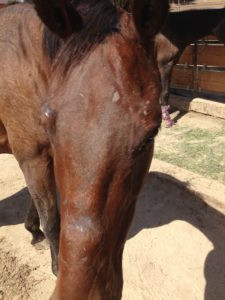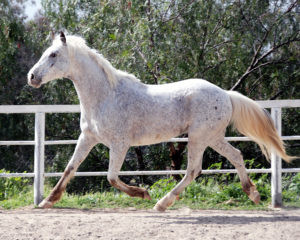 charro-riding-abuse-cruelty-dancing
charro-riding-abuse-cruelty-dancing
Ulysses, a rescued horse with visible scars from Charro riding abuse, stands as a testament to the cruelty inflicted upon “dancing horses.” He was once so neglected and abused that a shelter considered euthanasia. Today, Ulysses serves as a Horse Ambassador at Hanaeleh, embodying the suffering endured by horses subjected to the brutal practices of Charro riding. Rescued from Riverside Animal Shelter as a starving stray, Ulysses arrived at Hanaeleh bearing the physical and emotional scars of his past trauma.
His body was a canvas of abuse, marked with cuts and scars across his legs, back, chest, neck, and face. Every inch of him told a story of pain. His front legs displayed multiple bowed tendons and scarring from repeated blunt force trauma. Even years later, the scars on his hips, back, and flank remain visible reminders of the torment he endured. Adding to his physical wounds, Ulysses suffers from limited eyesight and neurological issues – conditions directly attributed to the abusive Charro training methods he was subjected to, not natural ailments.
Please consider donating to Hanaeleh today. Your contribution, no matter the size, can help us rescue more horses from the clutches of Charro abuse.
What Exactly is Charro Riding?
The term Charro refers to a Mexican cowboy, and the tradition originated from the practical need for skilled horsemen to manage large herds of cattle. While historically rooted in ranching, Charro riding has evolved into a performance discipline practiced in arenas, often with minimal or no cattle involvement. The saddles used in Charro riding are reminiscent of those used in traditional cattle herding and roping, frequently heavy and adorned with large pommels. These saddles are often elaborately decorated with silver and vibrant colors. However, beneath the colorful spectacle lies a harsh reality: Charro riding is often associated with significant horse abuse, particularly in the pursuit of creating “dancing horses.”
In regions like California, the devastating consequences of “charroed” horses are frequently encountered by equine rescue organizations. These horses bear the physical and psychological scars of the abusive training practices common in this discipline.
NOTE: Hanaeleh is committed to providing transparent and factual information about equine abuse, even when the details may be disturbing. Our goal is to educate and raise awareness, ensuring you have a clear understanding of the realities of Charro horse abuse.
The Myth of “Dancing”: Charro Riding as Horse Abuse
 charro-riding-abuse-cruelty-dancing
charro-riding-abuse-cruelty-dancing
Ulysses’ face, scarred from abusive Charro training methods, poignantly illustrates the suffering endured by these horses.
Charro riding often features “dancing horses,” where horses are forced to prance and perform elevated gaits while the rider remains seemingly at ease. This “dance” is not a display of willing athleticism but a manifestation of fear and agitation in the horse. The training methods employed to achieve this “dance” are rooted in cruelty and fear.
To force horses into the unnatural movements perceived as “dancing” – often a distorted imitation of piaffe or passage – horses are subjected to brutal training regimes. They are typically cross-tied on wooden planks, restricting their forward movement. While restrained, one person stands behind the horse with a whip, while two others at the front alternately strike the horse’s legs with sticks or whips. Driven by pain and terror, the horse quickly learns to lift its feet to escape the blows. These relentless beatings are likely the source of Ulysses’ extensive scarring on his legs and back.
Drawing parallels to the abusive training of Tennessee Walking Horses for saddleseat, Charro practitioners often use chains attached to the horses’ legs. This cruel method is designed to exaggerate the horses’ leg movements, creating a more “dramatic” and unnatural gait that is falsely presented as “dancing.” However, the reality is that the horse is driven by the fear of being injured by the chains slamming against their legs, not by any willing participation in a dance.
The Cruel Practice of Head Tying in Charro Riding
Charro riders often prioritize foot movement over natural head and neck carriage. They aim to restrict head and neck motion, preventing the horse from evading spurs or displaying resistance. To achieve this unnatural stillness, a common Charro practice involves tying the horse’s head up extremely high, sometimes to the stall roof, or tightly to its chest. These methods force the horse’s neck muscles into a state of extreme tension and exhaustion. The resulting fatigue inhibits the horse’s ability to resist the rider’s harsh commands and spurs, forcing submission through pain and discomfort.
Neurological Damage: A Legacy of Charro Riding Abuse
Ulysses’ neurological issues are believed to be a direct consequence of the abusive Charro riding training he endured. Veterinary examinations suggest that his condition stems from pinched nerves in his neck, caused by the forceful and unnatural head and neck positions imposed during training. Tragically, the damage inflicted upon Ulysses before his rescue was irreversible. While Hanaeleh provides ongoing care, including neck massages and high doses of Vitamin E to improve circulation, his neurological condition remains a permanent reminder of the cruelty he suffered. He can never fully recover from the abuse that was inflicted upon him.
Horse “Tripping”: Another Facet of Charro Cruelty
Similar to some American cowboy practices, Charro riding also includes the brutal act of tripping. This involves roping a horse’s legs and violently throwing the animal to the ground, ostensibly for sport or to assert dominance. Tripping inflicts severe trauma on horses’ legs and joints, frequently causing permanent physical damage. Hanaeleh has encountered numerous horses, including ponies, rescued from tripping or abusive Charro training, exhibiting profound physical and emotional trauma. These horses often suffer complete mental breakdowns or become so fearful and traumatized that they are deemed unsafe to ride.
 charro-riding-abuse-cruelty-dancing
charro-riding-abuse-cruelty-dancing
Nevada, another victim of Charro abuse, suffered severe trauma and neglect, left to starve by those who once exploited him.
A Call for Ethical Charro Practices and Accountability
It is crucial to acknowledge that not all Charro riders engage in abusive practices. Undoubtedly, there are individuals within the Charro tradition who prioritize humane training and horse welfare. However, the undeniable reality is that organizations like Hanaeleh frequently encounter horses who are victims of severe Charro-related abuse. These are the horses discarded at auctions after suffering injuries that render them unusable for riding, their suffering ignored.
Ulysses’ story exemplifies the devastating aftermath of Charro abuse. Were it not for Hanaeleh’s intervention, this magnificent animal would have been euthanized – not due to any inherent fault of his own, but because of the deliberate cruelty inflicted upon him. He was abused because his trainers either lacked the knowledge of humane methods or simply chose to disregard ethical treatment in favor of forced performance.
Hanaeleh passionately urges those within the Charro community who reject abuse to actively condemn and challenge these cruel practices. It is imperative to hold abusive individuals accountable and prevent further suffering. Only through collective action and a commitment to ethical horsemanship can we protect horses like Ulysses from the horrors of abusive “dancing horse” training and other cruel Charro practices.
Please click the DONATE button below to support Hanaeleh’s mission. Your generosity enables us to continue rescuing, rehabilitating, and advocating for horses who have suffered from abuse. Help us spread awareness and save more horses from cruelty.
Hanaeleh is a registered 501(c)(3) nonprofit horse rescue organization (Tax ID 20-3255341) operating in Southern California since 2004. 100% volunteer-run and a Verified Rescue with the Global Federation of Animal Sanctuaries, every donation directly benefits the horses in our care.
We rescue horses of all breeds and ages. After providing rehabilitation and care, we strive to find them loving forever homes. For horses with severe neglect or abuse histories who are not adoptable, we offer sanctuary, ensuring they live their remaining days in safety, love, and with compassionate care.

